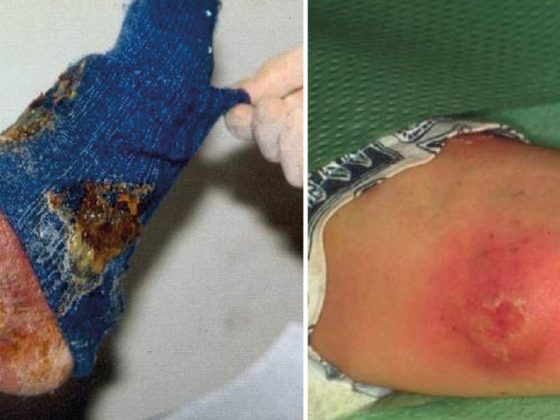The diagnosis and long-term treatment of people suffering from psychosis is unthinkable without family physicians. Their activities are also crucial for destigmatizing the disease – and those affected by it. When psychotic disorders are suspected, careful neurological and internal medicine diagnosis, including imaging and laboratory, is essential. The primary care physician can explain the need for such further testing and refer affected individuals. Emergency situations are rare in family practice. In this case, depending on the case, the involvement of the police, emergency psychiatrist and medical officer or emergency medication (controversial) is indicated. Primary care physicians can provide important input regarding the best course of action (medication and/or psychotherapy). Interactions between psychiatric and primary care medication are avoided through good communication among caregivers.
It is primary care providers who are first consulted by families or affected individuals when the first symptoms of psychosis appear. They make a tentative diagnosis, explain the clinical picture, and explain to the affected person the need to see a specialist or go to a psychiatric institution for further diagnosis and treatment. In particular, young people or their concerned relatives disclose to their primary care physician.
Thanks to the special relationship of trust, family doctors can reduce the fear of psychosis sufferers of being admitted to psychiatric institutions against their will and being treated violently, alienated from themselves and incapacitated. They convey to their patients and their relatives that there are effective, also non-drug therapies against the various forms of psychosis and clarify medical causes for psychiatric symptomatology (as present in about 20% of cases).
Diagnosis of psychotic disorders
Perception, thinking, and sensation are often altered in psychotic disorders. The ability to deal adequately with everyday stresses is impaired. However, behavior often changes minimally, making early diagnosis of psychotic disorders difficult and requiring specialized centers. Patients and those around them often find it difficult to accept that there may be a mental condition requiring treatment behind the difficulties they experience in their daily lives.
So-called “negative symptoms” such as listlessness, apathy and reduced performance are difficult to classify. They may not only be signs of a psychotic disorder, but may also stem from adjustment disorders following stressful life events, depressive episodes, “adolescent crises,” and somatic conditions. This should be considered in the differential diagnosis.
“Positive symptoms” such as content-related thought disorders, especially delusional thoughts and sensory delusions such as auditory hallucinations, quickly suggest psychosis. However, the etiology is not always clear. Even acute states of agitation can have a wide variety of causes, ranging from personality disorders, intoxications with legal and non-legal substances, bipolar affective disorders to brain-organic damage and/or internal diseases. Therefore, when psychotic disorders are suspected, careful neurological and internal medicine diagnosis, including imaging and laboratory, is essential.
The collection of psychopathological findings requires special knowledge. Obstacles arise even from simple linguistic misunderstandings. This is not only the case with foreign speakers when they describe “inner voices”, for example, so that professional interpreters should ask about the exact experience. Even native speakers can express fears that make it difficult to decide whether they are understandable fears in a highly technical world in which the individual is becoming a “transparent person” or whether paranoid thoughts of impairment and persecution are involved.
Mastering emergency situations
It is rather rare for a situation to arise in the family doctor’s office in which a decision must be made quickly and with little prior information as to whether a patient who may be psychotic is a danger to himself or others and what course of action is appropriate. Safety is the top priority here. If patients have the subjective impression of being in a threatening extreme situation in the context of their illness, they may be agitated, aggressive or suicidal.
If the person concerned can no longer be reached in conversation, becomes violent or is suicidal, then immediate withdrawal and the involvement of the police, emergency psychiatrist and – depending on the canton – medical officer is indicated. However, if the patient still responds to communication offers, he or she may be offered medication. Lorazepam (as a melting tablet, at least 2.5 mg in acute cases) is effective within 10-40 minutes for anxiety and agitation and is also indicated for delirium and catatonia. However, lorazepam does not counteract delusions and hallucinations, but merely has a frightening effect. Therefore, administration of benzodiazepines alone may still encourage a suicidal act or deed. Therefore, it is ideal to either combine haloperidol with lorazepam (5 mg haloperidol for the delusion and 2.5 mg lorazepam as de-anxiety) or to immediately intercept all symptoms with olanzapine (20 mg as a melting tablet, sedative, against delusions, hallucinations and largely without extrapyramidal motor side effects). When using 20 mg olanzapine as a stand-alone dose, one will cover both manic, psychotic, catatonic, and suicidal symptoms very well. The only caution required here is in delirium, where the anticholinergic properties of olanzapine may worsen symptoms. Whether medication should already be given in emergency situations in the primary care physician’s office is controversial. This is supported by faster treatment of patients and a less traumatizing environment. Ultimately, the knowledge and experience of the primary care provider are the deciding factors here.
Acute and maintenance therapy by specialists
Primary care physicians, who often know their patients long and well, can provide important input when deciding with patients after diagnosis whether drug treatment or psychotherapy, or a combination of both, is the best course of action. Great attention should be paid to informing patients and their relatives about the condition and to supporting the environment (including the involvement of social services).
Specialized psychologists are well acquainted with psychosis-specific psychotherapy methods; one example is metacognitive training, which can be downloaded free of charge from the homepage of the Hamburg University Hospital [1]. In the treatment of mental illness, including acute treatment, pharmacotherapy and psychotherapy have been shown to be on equal footing [2].
If antipsychotic medication is desired, then the specialist psychiatrist should develop tailored suggestions. Changes in medication, especially breaks in therapy of antipsychotics, should also be made in collaboration with the psychiatrist. Depending on the case, an inpatient stay for conversion may also be indicated.
Effect comparisons of pharmaceuticals
The effect of pharmacotherapies in schizophrenia and mania is well established. In schizophrenia phase prophylaxis, antipsychotics reduce relapses from 57 to 22% within one year. In bipolar disorder, 58% of patients respond to medication. Relapses decrease from 81 to 36% thanks to lithium. In acute mania, the response rate of various antipsychotics is 50%, with lithium 52%, with carbamazepine 51%, and with valproate 47%. Risperidone and olanzapine are comparably good, and their efficacy is better than that of valproate, ziprasidone, lamotrigine, topiramate, and gabapentin. In a large meta-analysis, the most effective neuroleptics for schizophrenia were found to be clozapine, followed by amisulpride, olanzapine, and then risperidone and paliperidone. It is important to note that clozapine in particular reduces mortality up to tenfold, in part because it can reduce suicides sixfold compared with the other neuroleptics [3]. It should also be mentioned that neuroleptics are most often discontinued because they do not work. In this respect, an absolutely good effect is match-critical for good compliance. Zotepine (discontinued since 2010) was ranked 6th, then haloperidol, quetiapine, aripiprazole, sertindole, ziprasidone, chlorpromazine, asenapine, lurasidone, and iloperidone was ranked 15th [3].
Therapy adherence, effect and side effects
Trust in the therapist is the most important factor in treatment adherence. The milder the symptoms of a disease, the more important the side effects of a medication and the more critically it is assessed. This also applies to psychotic disorders and the recommended antipsychotics, which have a number of adverse effects. A major concern for many patients is weight gain, which also has somatic consequences. It is highest under olanzapine and clozapine and lowest under haloperidol, lurasidone, and sertindole [3].
Other important adverse effects include extrapyramidal motor symptoms, sedation, prolactin elevation, and QT time prolongation [3]. When talking with patients on antipsychotic medication, adverse effects should be asked about regularly. The follow-up of these patients includes regular physical internistic-neurological examinations, ECG and laboratory tests. Drug level determinations provide information not only about adherence to therapy, but also about pharmacokinetic features. Absorption, metabolism, and excretion may vary widely among individuals and require adjustments in substance and administration.
However, side effects do not seem to be quite as decisive for the discontinuation of therapy with antipsychotics as the unsatisfactory efficacy of the respective drug. Amisulpride led to the fewest treatment discontinuations, according to studies, followed by clozapine and olanzapine. Most treatment discontinuations occurred with haloperidol, sertindole, and lurasidone [3].
Interactions between psychiatric and primary care medication are avoided by good communication between the treating psychiatrist and primary care physician. In cantons without self-dispensing, it is helpful to have the cooperation of the pharmacist, who has electronic systems that indicate interactions and contribute to safety when prescribing medications.
No psychosis management without family practice
Good psychosis management in family practice results in early diagnosis for those with illness, trust and true adherence can develop through effective therapy, and psychosis can be seen, interpreted, and balanced in the family context. Effective therapies (more than therapies with few side effects) are taken by sufferers over a long period of time and stabilize patients, prevent any professional and personal losses due to psychosis, reduce lost life time, and build confidence in the ever-improving and ultimately excellent treatment options. In fact, neuroleptics are highly effective in phase prophylaxis, significantly more effective than many internal medicine drugs, and have undergone strong improvements in recent years in terms of side effect rates and evidence-based use as defined by guidelines [4]. Also, specific psychotherapy procedures and conversation techniques have been shown to be at least equivalent to medications in their effectiveness, and the primary care physician can co-initiate such psychotherapeutic assistance. Timely and sustained therapies are less intrusive and prevent exacerbations and escalations. This helps the sufferers and their environment and reduces stigmatization of those affected.
Literature:
- Moeller J, Moritz S: Metacognitive training (MKT) for psychosis: promoting thinking about thinking. Psychiatry and Neurology 2015; 1: 4-9.
- Huhn M, et al: Efficacy of Pharmacotherapy and Psychotherapy for Adult Psychiatric Disorders. A Systematic Overview of Meta-Analyses. JAMA Psychiatry 2014; 71: 706-715.
- Leucht S, et al: Comparative efficacy and tolerability of 15 antipsychotic drugs in schizophrenia: a multiple-treatments meta-analysis. Lancet 2013; 382: 951-962.
- Leucht S, et al: Putting the efficacy of psychiatric and general medicine medication into perspective: review of meta-analyses. The British Journal of Psychiatry 2012; 200: 97-106.
HAUSARZT PRAXIS 2015; 10(9): 15-17











